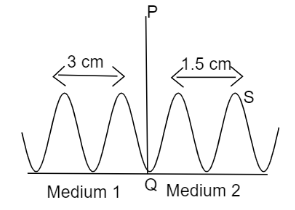
What is the ratio of speed of wave in medium

A.
B.
C.
D.

Answer
405.3k+ views
Hint:Whenever the wave travels in the medium then it travels with some velocity which is known as wave velocity or velocity of wave. The velocity of a wave is equal to the product of the frequency of the wave and the wavelength of the wave in that medium respectively. We will find the ratio of speed of wave in both mediums respectively by using the relation of wavelength and wave velocity.
Complete step by step answer:
The distance between consecutive crests or consecutive troughs of a wave is known as the wavelength of the wave. Let us assume that a wave travels with wavelength
Where
According to question the wavelength of wave in medium
Similarly in medium
On taking ratio of equation
Therefore the speed of the wave in medium first is double that that of medium second. The ration comes to be
Hence the correct option is A.
Note: The wave velocity also depends on the frequency of the wave in the respective medium, but here the frequency does not change therefore we can ignore the frequency. Thus more the wavelength of the wave will be its speed in an equal interval of time.
Complete step by step answer:
The distance between consecutive crests or consecutive troughs of a wave is known as the wavelength of the wave. Let us assume that a wave travels with wavelength
Where
According to question the wavelength of wave in medium
Similarly in medium
On taking ratio of equation
Therefore the speed of the wave in medium first is double that that of medium second. The ration comes to be
Hence the correct option is A.
Note: The wave velocity also depends on the frequency of the wave in the respective medium, but here the frequency does not change therefore we can ignore the frequency. Thus more the wavelength of the wave will be its speed in an equal interval of time.
Latest Vedantu courses for you
Grade 11 Science PCM | CBSE | SCHOOL | English
CBSE (2025-26)
School Full course for CBSE students
₹41,848 per year
Recently Updated Pages
Master Class 11 Economics: Engaging Questions & Answers for Success

Master Class 11 Business Studies: Engaging Questions & Answers for Success

Master Class 11 Accountancy: Engaging Questions & Answers for Success

Master Class 11 English: Engaging Questions & Answers for Success

Master Class 11 Computer Science: Engaging Questions & Answers for Success

Master Class 11 Maths: Engaging Questions & Answers for Success

Trending doubts
State and prove Bernoullis theorem class 11 physics CBSE

1 ton equals to A 100 kg B 1000 kg C 10 kg D 10000 class 11 physics CBSE

State the laws of reflection of light

One Metric ton is equal to kg A 10000 B 1000 C 100 class 11 physics CBSE

1 Quintal is equal to a 110 kg b 10 kg c 100kg d 1000 class 11 physics CBSE

Difference Between Prokaryotic Cells and Eukaryotic Cells




